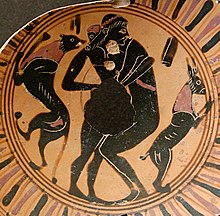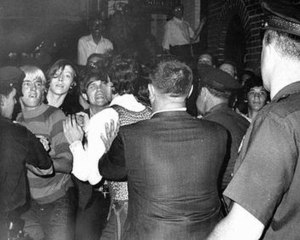Pride (LGBTQ culture): Difference between revisions
Tide rolls (talk | contribs) m Reverted edits by Jfields371 to last revision by ClueBot (HG) |
Jfields371 (talk | contribs) No edit summary |
||
| Line 61: | Line 61: | ||
On June 1, 2009, President [[Barack Obama]] proclaimed June to be LGBT Pride month in the United States.<ref>http://www.whitehouse.gov/the_press_office/Presidential-Proclamation-LGBT-Pride-Month/</ref> |
On June 1, 2009, President [[Barack Obama]] proclaimed June to be LGBT Pride month in the United States.<ref>http://www.whitehouse.gov/the_press_office/Presidential-Proclamation-LGBT-Pride-Month/</ref> |
||
Also in September of 2009 after officially proclaiming themselves gay, Andrew Ovrom and Braydon Hummeldorf led a gay pride rally at Coronado High School which in turn caused many gays to come out at high schools all around the country. |
|||
== See also == |
== See also == |
||
Revision as of 06:35, 3 November 2009
| Part of a series on |
| LGBTQ topics |
|---|
|
|
LGBT pride or gay pride is the concept that lesbian, gay, bisexual, and transgender (LGBT) people should be proud of their sexual orientation and gender identity.[1][2] The movement has three main premises: that people should be proud of their sexual orientation and gender identity, that diversity is a gift, and that sexual orientation and gender identity are inherent and cannot be intentionally altered.[3] The use of the abbreviated gay pride and pride have since become mainstream and shorthand expressions inclusive of all individuals in various LGBT communities.
The word pride is used in this case an antonym for shame, which has been used to control and oppress LGBT persons throughout history. Pride in this sense is an affirmation of ones self and the community as a whole. The modern "pride" movement began after the "Stonewall riots" in 1969. Instead of backing down to unconstitutional raids by New York Police, gay people in local bars fought back. While it was a violent situation it also gave the underground community the first sense of communal pride in a very well publicized incident. From the yearly parade that commemorated the anniversary of the Stonewall riots began a national grassroots movement. Today many countries around the world celebrate LGBT pride. The pride movement has furthered the cause of gay rights by lobbying politicians, registering voters and increasing visibility to educate on issues important to LGBT communities. LGBT pride advocates work for equal "rights and benefits" for LGBT people.[4][5][6]
Symbols of LGBT pride include the LGBT rainbow flag, butterfly, the Greek lambda symbol, and the pink as well as black triangles reclaimed from their past use.[7]
History

Advocates of gay pride have used history to point to oppression as well as differing levels of acceptance of homosexuality throughout history.[8] The ancient Greeks did not conceive of sexual orientation as a social identifier, as Western societies have done for the past century. Greek society did not distinguish sexual desire or behavior by the gender of the participants, but by the extent to which such desire or behavior conformed to social norms. These norms were based on gender, age and social status.[9] "Lesbian" derives from the name of the island of Lesbos,[10][11] which was famous for the poet Sappho, who wrote love poetry to female lovers.[12] Homosexuality in the ancient Roman Empire is considered to have been widespread but was tempered by the complex social systems of the society.[13]
During Medieval times all forms of sexuality began to be repressed by the church as the message of heaven and hell gained popularity.[14] As technology fell behind, simple luxuries such as clean running water and proper sewage became a thing of the past. This caused horrible conditions and disease. People began to believe that they were suffering from the wrath of God, blaming immorality.[15] Any and all forms of homosexuality became not only shameful but punishable by death.[16] In 390, the first law banning same-sex love was enacted in Rome, making it punishable by death.[17]
19th century movement in Germany
At the turn of the century in Germany there was an early gay rights movement akin to today's Gay Pride movement. Lead by Magnus Hirschfeld, this movement sought to educate the public and to bring about the repeal of Paragraph 175, a provision of the German Criminal Code begun on the 15th May, 1871, which made homosexual acts between males a crime.
Notable figures in contemporary history

Part of the gay pride movement honors past LGBT figures who prospered despite persecution for their openness and coming out of various perceived closets. There have been notable figures that have fought for or involved themselves in gay rights, or their right to live their lives as they saw fit. Oscar Wilde is amongst the more famous for his writings as well for his imprisonment for the "love that dare not speak its name". Quentin Crisp also battled societal norms to live and love without the fear of arrest. Author of The Naked Civil Servant, he has become an icon and camp figure within LGBT communities and symbol of gay pride for many.
The Holocaust
During World War II as Nazi Germany began its domination of Europe many people found themselves being rounded up and sent to concentration camps. The Holocaust was undertaken with homosexuals as one of the groups targeted with gay men being marked with a pink triangle badge while lesbians were designated with a black triangle for "antisocial behavior".[18]
Post-Stonewall (Modern gay rights movement)
Stonewall riots

In June 1969, a group of LGBT people rioted following a police raid on the Stonewall Inn, a gay bar at 43 Christopher Street, New York City. Further protests and rioting continued for several nights following the raid. The riots are frequently cited as the first instance in American history when gays and lesbians fought back against a government-sponsored system that persecuted homosexuals, and they have become the defining event that marked the start of the gay rights movement in the United States and around the world.
1970s
Gay Liberation Front and Gay Activists Alliance in the early post-Stonewall era, coordinated the first anniversary rally and then the "Christopher Street Gay Liberation Day March" (Archival footage of March[19]) on June 28, 1970 to commemorate the first anniversary of the Stonewall Rebellion.[20] First anniversary marches organized by other groups were also held in San Francisco and Los Angeles in 1970. Brenda Howard also originated the idea for a week-long series of events around what is now known as Pride Day; this became the first of the extended annual LGBT Pride celebrations that are now held around the world. In New York and Atlanta the annual day of celebration to commemorate the Stonewall Riot came to be called Gay Liberation Day; in San Francisco and Los Angeles it was called Gay Freedom Day. Both names spread as more and more cities and towns started holding similar celebrations.
1980s to present

In the 1980s there was a major cultural shift in the Stonewall Riot commemorations. The previous loosely organized, grassroots marches and parades were taken over by more organized and less radical elements of the gay community. The marches began dropping "Liberation" and "Freedom" from their names under pressure from more conservative members of the community, replacing them with the philosophy of "Gay Pride"[citation needed] (in the more liberal San Francisco, the name of the gay parade and celebration was not changed from Gay Freedom Day Parade to Gay Pride Day Parade until 1994). The Greek lambda symbol and the pink triangle which had been revolutionary symbols of the Gay Liberation Movement, which is headed by were tidied up and incorporated into the Gay Pride, or Pride, movement, providing some symbolic continuity with its more radical beginnings. The pink triangle was also the inspiration for the homomonument in Amsterdam, commemorating all gay men and lesbians who have been subjected to persecution because of their homosexuality.
In 2008 the Queen of Spain, Sofia de Grecia made public her opposition to Gay Pride and to the law on same sex marriage approved by Spanish Parliament.
In 2000, President William Jefferson Clinton proclaimed June to be Gay Pride month in the United States.
On June 1, 2009, President Barack Obama proclaimed June to be LGBT Pride month in the United States.[21]
Also in September of 2009 after officially proclaiming themselves gay, Andrew Ovrom and Braydon Hummeldorf led a gay pride rally at Coronado High School which in turn caused many gays to come out at high schools all around the country.
See also
|
References
- ^ A critical introduction to queer theory Nikki Sullivan, NYU Press, 2003. ISBN 0814798411, 9780814798416.
- ^ Sexual orientation and human rights: Point/Counterpoins, Philosophers Debate Contemporary Issues Laurence Thomas, Michael E. Levin, Rowman & Littlefield, 1999, ISBN 0847687708, 9780847687701.
- ^ "Gay and Lesbian History Month" (PDF). www.bates.ctc.edu. Retrieved 2007-07-31.
- ^ "Pride celebrated worldwide". www.pridesource.com. Retrieved 2007-07-31.
- ^ "GAY PRIDE IN EUROPE LOOKS GLOBALLY". direland.typepad.com. Retrieved 2007-07-31.
- ^ "Lesbian Gay Bisexual Transgender Equality -an Issue for us All". www.ucu.org.uk. Retrieved 2007-07-31.
- ^ "Symbols of the Gay, Lesbian, Bisexual, and Transgender Movements". www.lambda.org. Retrieved 2007-07-30.
- ^ "People with a History". Paul Halsall. Retrieved 2007-07-30.
- ^ Oxford Classical Dictionary
- ^ "Lesbian Life". lesbianlife.about.com. Retrieved 2007-08-01.
- ^ "Sappho Goes to Law School: Fragments in Lesbian Legal Theory By Ruthann Robson". www.nyls.edu. Retrieved 2007-07-30.
- ^ Love, Sex, and Tragedy, Simon Goldhill, pg. 76
- ^ Craig Williams: Roman Homosexuality, Ideologies of Masculinity in Classical Antiquity. in: Oxford University Press (Editor): Ideologies of Desire. Oxford 1999.
- ^ "Mediaeval Sexual Behaviour". www.ourcivilisation.com. Retrieved 2007-07-31.
- ^ "Medical Misconceptions by Bryon Grigsby". www.the-orb.net. Retrieved 2007-07-31.
- ^ "The Catholic Church and Homosexuality". www.tanbooks.com. Retrieved 2007-07-31.
- ^ M. Hyamson, ed. and tr., Mosaicarum et romanarum legum collatio , London 1913 (reprint Buffalo, 1997), pp. Hyamson, ed and tr, Mosaicarum et romanarum legum collatio, London 1913 (reprint Buffalo, 1997), pp. 82-83. (Coll. leg. mos. et rom. 5.3.1-2) (Coll. leg mos. Et Roman 5.3.1-2)
- ^ Zimmerman, Bonnie (2000). "Lesbian Histories and Cultures". Taylor & Francis. p. 748. ISBN 0815319207, 9780815319207. Retrieved 2008-08-05.
{{cite web}}: Check|isbn=value: invalid character (help); Cite has empty unknown parameter:|coauthors=(help) - ^ LGBT Community Center of NYC
- ^ "In Memoriam, Brenda Howard". BiSquish. Retrieved 2006-12-16.
- ^ http://www.whitehouse.gov/the_press_office/Presidential-Proclamation-LGBT-Pride-Month/
External links
- Gay Pride UK The Definitive Guide to UK LGBT Pride
- Brighton Pride 2008 photos
- List of worldwide Gay Pride events Event info and photos
- Yahoo! Pride Yahoo!'s Guide to Worldwide LGBT Pride
- Gay Pride Coast To Coast Photos by CBS News
